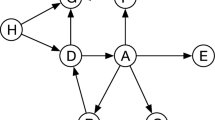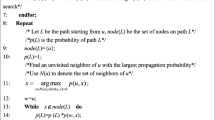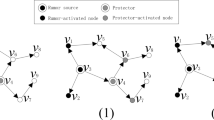Abstract
In social networks, a phenomenon termed the refutation mechanism arises when certain users spontaneously counter negative information based on their knowledge and experience. To the best of our knowledge, this paper focuses on the influence blocking maximization under the refutation mechanism for the first time. Specifically, incorporating the refutation mechanism with the Competitive Independent Cascade model, we introduce the Refutation Competitive Independent Cascade model, while also considering real-time delay. Under the proposed model, we study the Joint Influence Blocking Maximization (JIBM) problem. The objective of JIBM is to maximize the expected number of nonnegatives by finding a set of positive seeds in a network. We show that the problem is NP-hard. We present a scalable approximation algorithm, named RR-JIBM, by making a non-trivial adaptation of the generation process of reverse reachable sets. We prove that the given algorithms achieve a \((1-1/e-\varepsilon )\)-approximation for any \(\varepsilon > 0\) for JIBM problem. An improved algorithm named RR-JIBM+ is also proposed to improve the efficiency of RR-JIBM in reality. Experiments on real-world social networks show that our algorithms outperform other intuitive baselines in reducing the number of nodes influenced by negative seed nodes. Meanwhile, the RR-JIBM+ algorithm has a higher efficiency advantage than RR-JIBM on different datasets.







Similar content being viewed by others
Data availability
All the datasets can be accessed from http://snap.stanford.edu/data/index.html and http://konect.cc/networks.
Notes
http://snap.stanford.edu/data/index.html
http://konect.cc/networks
References
Banerjee A, Chandrasekhar AG, Duflo E, Jackson MO (2013) The diffusion of microfinance. Science 341(6144):1236498
Borgs C, Brautbar M, Chayes J, Lucier B (2014) Maximizing social influence in nearly optimal time. In: Proceedings of the twenty-fifth annual ACM-SIAM symposium on discrete algorithms
Borodin A, Filmus Y, Oren J (2010) Threshold models for competitive influence in social networks. In: Internet and network economics - 6th international workshop, WINE. Lecture Notes in Computer Science, 6484: 539–550
Bovet A, Makse HA (2019) Influence of fake news in Twitter during the 2016 US presidential election. Nat Commun 10(1):7
Braunstein A, Dall’Asta L, Semerjian G, Zdeborová L (2016) Network dismantling. Proc Natl Acad Sci 113(44):12368–12373
Budak C, Agrawal D, El Abbadi A (2011) Limiting the spread of misinformation in social networks. In: Proceedings of the 20th international conference on world wide web
Chen W (2018) An issue in the martingale analysis of the influence maximization algorithm imm. In: Computational data and social networks
Chen W, Wang Y, Yang S (2009) Efficient influence maximization in social networks. In: Proceedings of the 15th ACM SIGKDD international conference on knowledge discovery and data mining, pp. 199–208
Chen D, Lü L, Shang M-S, Zhang Y-C, Zhou T (2012) Identifying influential nodes in complex networks. Physica A Statist Mech Appl 391(4):1777–1787
Chen W, Lakshmanan LVS, Castillo C (2013) Inform Influ Propagation Soc Netw. Synthesis Lectures on Data Management. Morgan & Claypool Publishers, California, United States
Chen B-L, Jiang W-X, Chen Y-X, Chen L, Wang R-J, Han S, Lin J-H, Zhang Y-C (2022) Influence blocking maximization on networks: Models, methods and applications. Phys Rep 976:1–54
Del Vicario M, Bessi A, Zollo F, Petroni F, Scala A, Caldarelli G, Stanley HE, Quattrociocchi W (2016) The spreading of misinformation online. Proc Natl Acad Sci 113(3):554–559
Domingos P, Richardson M (2001) Mining the network value of customers. In: Proceedings of the 7th ACM SIGKDD international conference on knowledge discovery and data mining, pp 57–66
Fan C, Zeng L, Sun Y, Liu Y-Y (2020) Finding key players in complex networks through deep reinforcement learning. Nat Mach Intell 2(6):317–324
He X, Song G, Chen W, Jiang Q (2012) Influence blocking maximization in social networks under the competitive linear threshold model. In: SDM
Jones NM, Thompson RR, Schetter CD, Silver RC (2017) Distress and rumor exposure on social media during a campus lockdown. Proc Natl Acad Sci 114(44):11663–11668
Kempe D, Kleinberg J, Tardos E (2003) Maximizing the spread of influence through a social network. In: Proceedings of the ninth ACM SIGKDD international conference on knowledge discovery and data mining
Kimura, Masahiro, Saito, Kazumi, Motoda, Hiroshi (2008) Minimizing the spread of contamination by blocking links in a network. In: Proceedings of the 23rd national conference on artificial intelligence - vol 2
Kitsak M, Gallos LK, Havlin S, Liljeros F, Muchnik L, Stanley HE, Makse HA (2010) Identification of influential spreaders in complex networks. Nat Phys 6(11):888–893
Lu W, Chen W, Lakshmanan LVS (2015) From competition to complementarity: comparative influence diffusion and maximization
Masahiro Kimura, Kazumi Saito, Hiroshi Motoda (2009) Blocking links to minimize contamination spread in a social network. ACM Trans Knowl Discov Data 3(2):1–23
Medya S, da Silva AL, Singh AK (2020) Approximate algorithms for data-driven influence limitation. IEEE Trans Know Data Eng 34(6):2641–2652
Morone F, Makse HA (2015) Influence maximization in complex networks through optimal percolation. Nature 524(7563):65–68
Mugisha S, Zhou H-J (2016) Identifying optimal targets of network attack by belief propagation. Phys Rev E 94:012305
Paluck EL, Shepherd H, Aronow PM (2016) Changing climates of conflict: a social network experiment in 56 schools. Proc Natl Acad Sci 113(3):566–571
Ren X-L, Gleinig N, Helbing D, Antulov-Fantulin N (2019) Generalized network dismantling. Proc Nat Acad Sci 116(14):6554–6559
Shao C, Ciampaglia GL, Varol O, Yang K-C, Flammini A, Menczer F (2018) The spread of low-credibility content by social bots. Nat Commun 9:4787
Tang Y, Shi Y, Xiao X (2015) Influence maximization in near-linear time: a martingale approach. In: Proceedings of the 2015 ACM SIGMOD international conference on management of data
Tong G, Du DZ (2019) Beyond uniform reverse sampling: a hybrid sampling technique for misinformation prevention
Tong G, Wu W, Du D (2018) Distributed rumor blocking with multiple positive cascades. IEEE Trans Comput Soc Syst 5(2):468–480
Vosoughi S, Roy D, Aral S (2018) The spread of true and false news online. Science 359(6380):1146–1151
Wang B, Chen G, Fu L, Song L, Wang X (2017) Drimux: dynamic rumor influence minimization with user experience in social networks. IEEE transactions on knowledge and data engineering
Wu P, Pan L (2017) Scalable influence blocking maximization in social networks under competitive independent cascade models. Comput Netw 123:38–50
Yan R, Li D, Wu W, Du DZ (2018) Minimizing influence of rumors by blockers on social networks. In: CSoNet
Yan R, Li D, Wu W, Du DZ, Wang Y (2020) Minimizing influence of rumors by blockers on social networks: algorithms and analysis. IEEE transactions on network science and engineering
Yao Q, Guo L (2015) Minimizing the social influence from a topic modeling perspective. In: ICDS
Yao Q, Zhou C, Xiang L, Cao Y, Guo L (2014) Minimizing the negative influence by blocking links in social networks. In: ISCTCS
Yao Q, Shi R, Zhou C, Wang P, Guo L (2015) Topic-aware social influence minimization. Proceedings of the 24th international conference on world wide web
Zhang H, Zhang H, Li X, Thai MT (2015) Limiting the spread of misinformation while effectively raising awareness in social networks. In: Computational social networks - 4th international conference, CSoNet, 9197: 35–47
Zhu J, Ni P, Wang G (2020) Activity minimization of misinformation influence in online social networks. IEEE Transact Comput Soc Syst 7(4):897–906
Acknowledgements
The work described in this paper was partially supported by InnoHK initiative, The Government of the HKSAR, and the Laboratory for AI-Powered Financial Technologies.
Funding
National Key Research and Development Program of China under Grant 2020YFB1005900, National Natural Science Foundation of China (NSFC) under Grant 62122042, Shandong University multidisciplinary research and innovation team of young scholars under Grant 2020QNQT017.
Author information
Authors and Affiliations
Contributions
QL and DY wrote the manuscript, YZ and YZ collected the data, DW designed the experiments, and ZC analyzed the results. All authors reviewed the results and approved the final version of the manuscript.
Corresponding author
Ethics declarations
Conflict of interest
We declare that the authors have no known competing interests or personal relationships that might be perceived to influence the discussion reported in this paper.
Ethical approval
not applicable.
Additional information
Publisher's note
Springer Nature remains neutral with regard to jurisdictional claims in published maps and institutional affiliations.
Rights and permissions
Springer Nature or its licensor (e.g. a society or other partner) holds exclusive rights to this article under a publishing agreement with the author(s) or other rightsholder(s); author self-archiving of the accepted manuscript version of this article is solely governed by the terms of such publishing agreement and applicable law.
About this article
Cite this article
Luo, Q., Yu, D., Wang, D. et al. Influence blocking maximization under refutation. Soc. Netw. Anal. Min. 13, 143 (2023). https://doi.org/10.1007/s13278-023-01123-7
Received:
Revised:
Accepted:
Published:
DOI: https://doi.org/10.1007/s13278-023-01123-7




